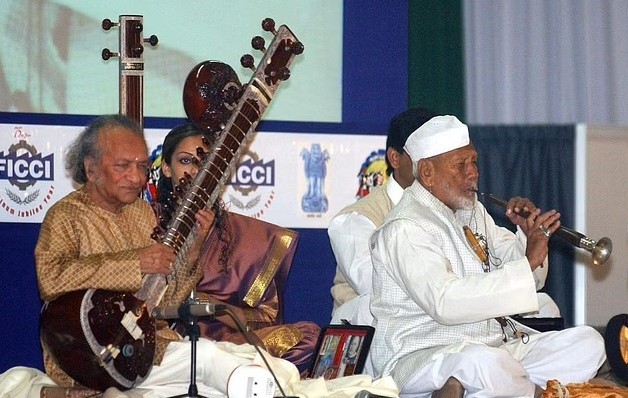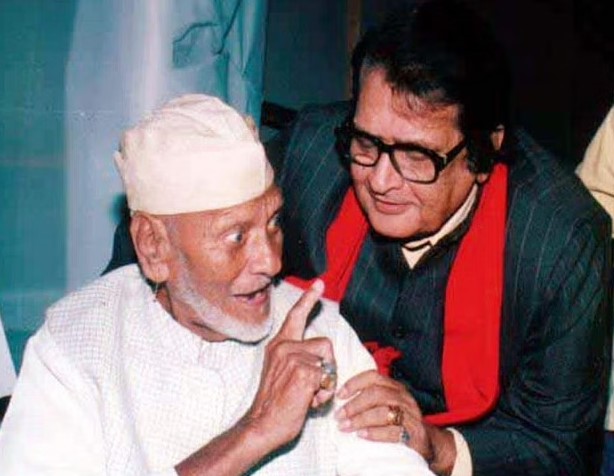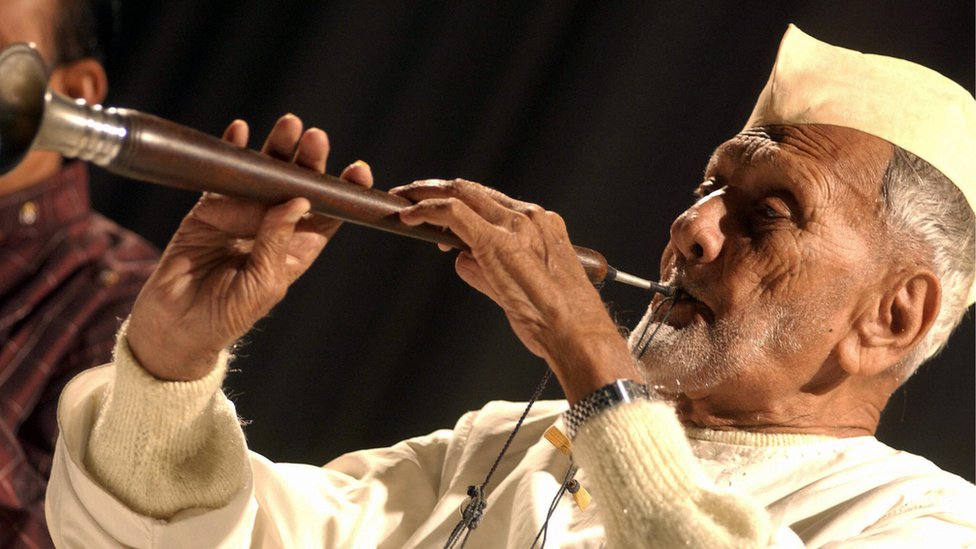We wouldn’t have discovered the full potential of the Shehnai if it weren’t for Bismillah Khan. As a result of his efforts, the Shehnai, a subcontinental oboe, became a household name. The instrument that was once considered a mere folk instrument has been elevated to the status of a classical instrument. In addition, because of Bismillah Khan, it not only attracted Asian music fans but also made millions of Westerners aware of and appreciate Shehnai’s potential. To the point where he referred to his guitar as his wife, he’d become deeply devoted to it. It’s one thing to fall in love with something; quite another to inspire millions of others to do the same. And that’s exactly what the world’s most revered Shehnai player accomplished during his legendary reign.
Table of Contents
Childhood
Paigambar Khan and Mitthan’s second son, Bismillah Khan, was born in Buxar district in Bihar on 21 March 1916. He was given the name Qamaruddin in honour of his elder brother Shamsuddin, whose name sounded similar to his. While he was still a baby, Rasool Baksh Khan uttered the word “Bismillah” and thus Bismillah Khan was born. Several generations of his ancestors worked as court musicians in the Bhojpur princely states.
It is said that his father used to play Shehnai for the Maharaja of Dumroon, Keshav Prasad Singh, in his court. Bismillah was, of course, exposed to Shehnai at an early age. He grew up watching his father play the wind instrument, so he decided to do the same. His uncle, Ali Baksh ‘Vilayatu,’ accompanied him on his journey to Varanasi when he was just six years old. Young Bismillah looked up to his uncle as his Guru and studied the instrument’s nuances with him until he was an expert.
Career
At the beginning of his career, Bismillah Khan performed at a number of stage shows. At the All India Music Conference in Calcutta in 1937, he had his first major breakthrough. Shehnai gained popularity and acclaim as a result of this performance. After that, he went on to play in Afghanistan, the United States, Canada, Bangladesh, Iran, Iraq, West Africa, Japan, Hong Kong, and various European countries. Throughout his illustrious career, he appeared in numerous high-profile events around the globe. He has performed at a variety of events, including the Montreal World Exposition, the Cannes Art Festival, and the Osaka Trade Fair, among others.
An Exceptional Achievement
When India gained its independence in 1947, Bismillah Khan had the unique opportunity to play his Shehnai on the eve of it. Afterwards, the Prime Minister of India gave a speech at the Red Fort in Delhi, where he performed for the first time. For a long time, Bismillah’s performance was the highlight of the country’s Independence Day festivities. Doordarshan’s live broadcast of his performance reached tens of thousands of people.


In the Bollywood film industry
In the Hindi film “Goonj Uthi Shehnai,” Bismillah Khan performed the shehnai. Other well-known musicians like Abdul Halim Jaffar Khan and Amir Khan also performed in the film, which was a huge hit. Vasant Desai composed the music for it.
‘Sanaadi Appanna’ was the Kannada film that the Varanasi maestro worked on at the Prasad Studios in Chennai in 1977. He and his ten-person troupe spent nine days in the city. Dr. Rajkumar’s character, a rural shehnai artiste, convinced him to work on the film. The film’s soundtrack was composed by G. K. Venkatesh, and Bismillah Khan’s brilliance was the film’s main component.
For Bismillah Khan, Goutam Ghose directed the documentary, “SangeMeel Se Mulaqat,” about the singer’s life. As a young shehnai player, the film follows the maestro’s development into one of India’s finest.
Was Bismillah Khan truly exceptional?
Shehnai recitals in the post-independence era were all but monopolised by Bismillah Khan, who did much to preserve classical music in the country. His belief that music would live on even if the rest of the world did not is what truly makes him an artist and music lover. For him, Hinduism and Islam were two religions that could coexist peacefully. He insisted that there was no caste system in music.
Bismillah Khan never forgot where he came from, no matter how successful he became. He didn’t amass any material possessions, preferring instead to live in poverty in the holy city of Benares. He was so in love with his hometown that he turned down a permanent Visa to live in the United States.
Bismillah Khan was not only a proponent of Hindu-Muslim harmony but also a role model in this regard. No one could stop him from paying homage to the Hindu goddess Saraswati, despite the fact that he was a devout Shia Muslim.


A fascinating story about the maestro’s possible encounter with Lord Krishna is also available! Bismillah Khan was on a train from Jamdshedpur to Varanasi, where he was scheduled to perform in a religious concert, when the storey begins. Unable to ignore an impressionable 12-year-old with a flute in his hand as he made his way down the street. When the youngster began playing his instrument, the maestro was taken aback because he had no idea what the ‘raaga’ was. He was quick to notice the divinity in this young boy’s music, and he asked him to play the same piece over and over.
Bismillah Khan is said to have played the same tune he learned from the mysterious youngster upon his arrival in Varanasi. The Ustad told contemporary musicians and greats that the ‘raaga’ he played is called ‘Kanhaira’ when they inquired about it.
Awards and Achievements
- Bharat Ratna
- Padma Vibhushan
- Padma Bhushan
- Padma Shri
- Sangeet Natak Akademi Award
- Tansen Award
- Talar Mausiquee


Personal life
Bismillah Khan was a likeable character because of his modest upbringing. He lived off of rice and dal and rode a cycle rickshaw everywhere. Bismillah Khan enjoyed spending time with his large family. He had adopted a daughter in addition to his five biological sons. As a result, his family grew, and he was able to raise his grandchildren and great grandchildren as his own children.
Death
On August 17, 2006, Ustaad Bismillah Khan was admitted to the Heritage Hospital in Varanasi for treatment after his health began to deteriorate. On August 21, 2006, at the age of 90, he died of a cardiac arrest. Fatemaan burial ground in the old city of Varanasi is where he was buried with another Shehnai.
Trivia
- As Qamaruddin Khan, he was born, but he later changed it to “Bismillah.” His grandfather is said to have said “Bismillah” in gratitude to Allah when he learned of his grandson’s birth, and that’s how he got his middle name, Bismillah.
- When Khan visited Varanasi, he learned to play the shehnai from his maternal uncle Alibaksh Vilayati. Khan honed his raga skills in a variety of styles, including Thumri, Chaitti, Kajri, and Swani, among others. When he was a teenager, he took up Khayal music as well.
- In 1937, at the Indian Music Conference in Kolkata, Bismillah Khan gave his first public performance. His big break came in 1938, when he was offered a position at Lucknow’s All India Radio station. After performing at the Edinburgh Music Festival, he gained worldwide fame.
- In celebration of India’s first Republic Day, Khan sang Raga Kaifi from the Red Fort on January 26, 1950.
- Several Hindi films have featured Khan as a shehnai player, including ‘Gunj Uthi Shehnai’. Sanaadi Appanna’s Karedaru Kelade song features him on shehnai, as well.
- He started worshipping Goddess Saraswati because he was a Shia Muslim, and music was forbidden and considered ‘haram’ in his religion.


